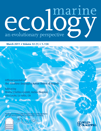Sea Ice, 2nd edn
Sea Ice , 2nd edn D.N. Thomas & G.S. Dieckmann ( Eds ) Oxford : Wiley-Blackwell , 2009 , 640 pp . ISBN 978-1-4051-8580-6 . Hardback: UK £ 89.99, US $ 152.99
The extraordinary exponential growth in the field of sea ice research in the last few years confirms the need for a new, 2010, edition of the book, Sea Ice, first edited by David N. Thomas and Gerhard S. Dieckmann in 2003.
Until the end of the last century, people only had a marginal idea about the key ecological role of sea ice on a global scale. Sea ice is one of the most dynamic ecosystems on our planet, and serves as one of the most important gears of the Earth’s climate. A huge amount of scientific research on the part of many research teams from around the world has been necessary to recognize this. Stephen Ackley, a pioneer of sea ice ecology, has written the foreword to the second edition of Sea Ice, which clearly and concisely relates the history of sea ice science. He emphasizes the importance of interdisciplinary studies in this field, in particular the linkage of physics and biology in sea ice studies. He himself initiated this effort at the late 1970s along with Kurt Burk and David Garrison, and this work was also carried out by Cornelius Sullivan and co-workers in the fast ice of McMurdo Sound in 1980. A first interdisciplinary study of drifting sea ice took place in the winter of 1986 on the AWI’s research vessel, Polarstern, by a team of researchers that included Dieckman, the co-editor of the book under review, and Eiken, Masson and Comiso, the authors of various chapters in the book. In many fields of earth science, an interdisciplinary approach is very important, but not always essential. We agree with Ackley, however, when he asserts that interdisciplinary sea ice studies are crucial in the Arctic and Antarctic regions to understand the functioning of these ecosystems. As stated in his foreword, these types of study are strongly supported by the Scientific Committee on Oceanic Research (SCOR), which organized a Working Group on Sea Ice Ecology in 1987; this approach was also emphasized at the newly instituted series of biennial Gordon Research Conferences on Polar Marine Science, which started in 1997.
The second edition of Sea Ice is divided into 15 thematic chapters (compared to the 11 chapters of the first edition), each of which can stand alone as a compelling and updated review. Thomas and Dieckman have once again drawn together an extremely impressive group of 32 contributing authors (compared to 16 in the first edition). Combined, they have made an extraordinary effort to provide the general reader, and not only specialists in the field, with the basic information available regarding the multifaceted aspects of sea ice research.
The topics covered include full reviews of the physics and thermodynamics of sea ice, the linkage between sea ice and global oceanography, and clues regarding the relationships between sea ice and snow, and global sea ice cover patterns (chapters 1–6). Sea Ice and Oceanography (chapter 3) and Snow and Sea Ice (chapter 5) are two new very important topics covered in this second edition. Chapters 7 to 12 provide a wide array of information about the biology and ecology of all the components of the ‘sea ice ecosystem’, from viruses to macrofauna, birds and mammals. Two new and important topics, namely Sea Ice Bacteria and Viruses (chapter 7), and Heterotrophic Protists Associated with Sea Ice (chapter 9), are thoroughly updated and discussed by the authors, notably enriching this second edition. Chapter 7 emphasizes the heretofore unstudied role of bacteria and viruses in sea ice. In addition, it describes the discovery of a large number of bacterial and viral species, many of which remain unidentified and which may disappear together with the multiyear pack ice of the Arctic. Chapter 9 emphasizes the role of the heterotrophic protists, the major consumers of microalgae and bacteria associated with sea ice. Three chapters (13–15) are dedicated, respectively, to paleo-sea ice distribution, to the analysis of sea ice in non-polar regions, and to sea ice as a terrestrial laboratory that may provide information about the possibility of extra-terrestrial life.
This book, to which almost all top scientists in sea ice science have contributed, is the reference text for experienced researchers in sea ice and polar science. The approach of the authors in describing an otherwise almost neglected component of the Earth’s biosphere accords well with the E2E approach (End-to-End food web approach, from viruses to whales). As such, it can be profitably used by neophyte scientists and researchers in both sea ice science and general ecology.
The writers of this book review have had the opportunity to exchange ideas and opinions with the authors, but unfortunately without the opportunity for deeper collaboration. We have, however, always used their book as a reference for our projects, and for our speculations about sea ice. Our future research proposals will certainly utilize the ideas and information in this book as a basic reference.
The publication of several interesting papers that have appeared in top peer-reviewed journals after the publication of this book clearly shows the importance of sea ice studies. It also underlines that, although much work has been done, much more remains. We strongly urge all scientists interested in sea ice science, and all general science readers, to add this book to their personal library.




